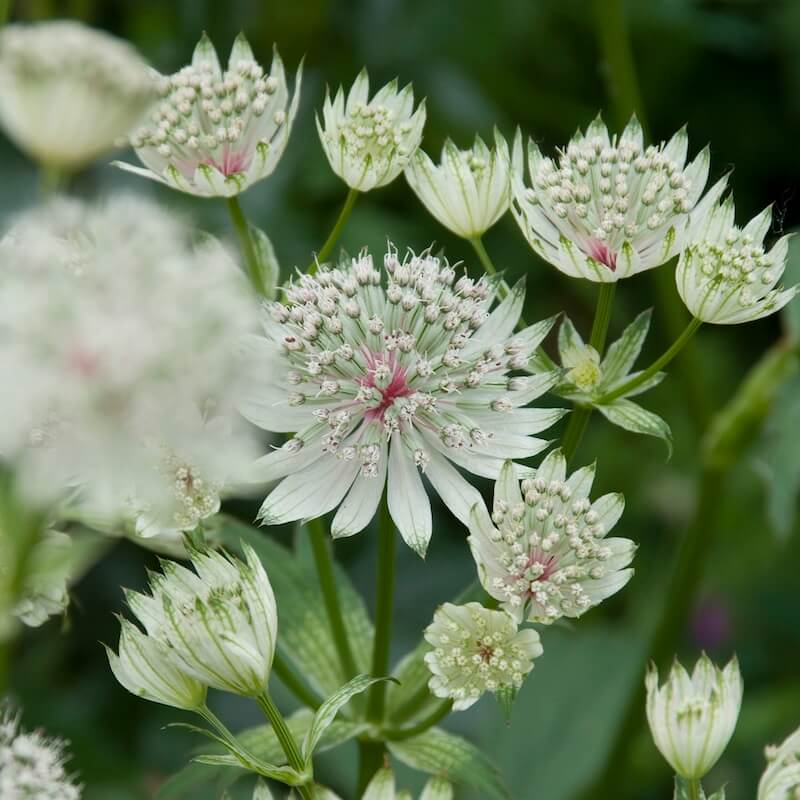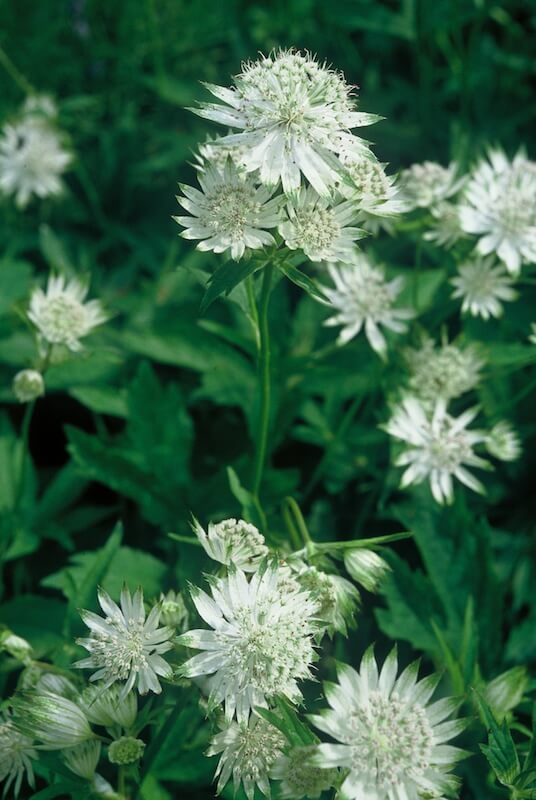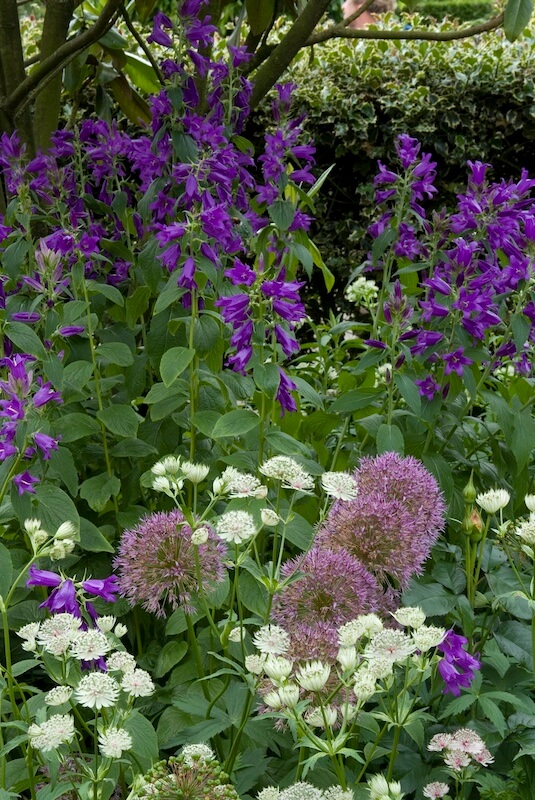Astrantia major Shaggy - A Cottage Garden Favourite
Astrantia major subsp. involucrata Shaggy, Masterwort Shaggy, Astrantia major Margery Fish, Astrantia major subsp. involucrata Margery Fish

Position
- Prefers partial shade but tolerates full sun if the soil remains consistently moist
- Ideal for borders, cottage gardens, damp meadows, or woodland-edge plantings
- Excellent companion for ferns, hostas, and other moisture-loving perennials
Hardiness
- Hardy down to at least –20°C (–4°F)
- Reliable for all but the harshest UK locations
Soil
- Thrives in fertile, moisture-retentive but well-drained soil
- Performs best in soils improved with compost, leaf mould, or well-rotted manure
- Will not thrive in very dry or sandy soils unless improved; dislikes prolonged waterlogging
- Tolerant of acid, neutral, or alkaline soils
- Very adaptable in most UK garden settings
- Grab a soil test kit and ensure the perfect conditions for growth
Height
- Usually grows to 60–75 cm (2–2.5 feet) tall over 5–10 years
- Forms a clump of upright stems with divided, toothed foliage
Seasons of Interest
- Foliage: Deep green, palmately-lobed leaves provide good ground cover from spring to autumn
- Autumn Colour/Variegation: Leaves may yellow a little before dying back; no variegation present
- Flowering: Large, shaggy-looking white flowers with greenish tips, held above the foliage on branched stems from June to September
- Flowers are very attractive to bees, butterflies, and other pollinators
Additional Notes
- Deadhead spent flowers to encourage a longer flowering period and reduce self-seeding if unwanted
- Mulch in spring with compost or leaf mould to retain moisture and boost soil fertility
- Water well in dry spells, especially during prolonged hot weather
- Generally pest and disease resistant and low maintenance
- Can be left undisturbed but may be divided in early spring or autumn if clumps become congested
- Excellent cut flower for fresh or dried arrangements
Astrantia major Shaggy - Ideal for Pollinators and Flower Arrangers
If you’re searching for a showstopping perennial with charm and history, Astrantia major Shaggy deserves a prime spot in your garden. Known for its star-like blooms and ruffled white bracts, this member of the involucrata group adds texture and character to borders, beds, and containers. Whether you’re an experienced gardener or just starting out, this herbaceous perennial is a joyful plant to grow.
What is Astrantia major Shaggy?
Astrantia major Shaggy is a vigorous cultivar of Astrantia major subsp. involucrata, a herbaceous perennial known for its unique flower structure. Often called masterwort, this variety stands out with large, shaggy flowerheads featuring pointed white bracts tipped with green.
The blooms of Shaggy appear from early summer and last well into late summer. Each flower consists of a central cluster of tiny, greenish-white flowers surrounded by narrow, pointed white bracts. These resemble stars or fireworks, bringing soft colours and intricate forms to borders and beds.
This plant’s architectural value is matched by its versatility. As a reliable perennial, it returns year after year with minimal fuss. It suits both formal borders and looser, cottage-garden planting styles if you like your plants to offer structure, beauty and pollinator appeal. Astrantia major Shaggy ticks every box.
Why Is Involucrata Shaggy So Popular?
The popularity of involucrata Shaggy is thanks to its refined yet natural appearance. The flowerheads seem both ornamental and wild, bringing a soft, textured quality to mixed plantings. Its pale tones blend beautifully with richer shades, such as the dark red astrantias, purple salvias, or blue geraniums.
Another reason is its long blooming period. This perennial starts flowering in early summer and often continues through August. Deadheading faded blooms can encourage further flower production, which makes Shaggy ideal for seasonal interest.
Finally, Shaggy thrives in typical UK conditions. It’s happy in partial shade or full sun, adapts to various soil types and tolerates moist soil. That makes it a resilient choice for gardeners dealing with dappled shade or borders that receive less light.

How Did Margery Fish Influence the Rise of Astrantias?
Much of the current interest in astrantias stems from Margery Fish, the celebrated plantswoman and garden writer. Her use of astrantias in her Somerset garden helped elevate them from cottagey curiosities to star performers.
Fish’s approach focused on texture, foliage, and subtle flower forms. She often planted masterwort beneath taller shrubs or beside paths where their fine details could be appreciated. The involucrata Shaggy variety fits perfectly into her vision of informal, accessible, and long-flowering garden plants.
Thanks to her influence, astrantia major cultivars—particularly those with distinctive bracts like Shaggy—are now staples in many British gardens.
Where Does Astrantia major Shaggy Grow Best?
One of the joys of growing Astrantia major Shaggy is its adaptability. It grows happily in full sun or partial shade, although it prefers a little afternoon respite in hotter areas. In sunnier spots, it benefits from moist soil and occasional mulching with garden compost.
This plant prefers fertile, humus-rich soil that is ideally enriched with organic matter. It thrives in well-drained soil that retains moisture without becoming overly wet. Shaggy can tolerate drier conditions once established, but young plants need consistent watering.
It also suits various garden situations—from shaded borders and woodland edges to informal cottage garden schemes. With its glossy green foliage and striking bracts, it plays well with ferns, hostas, and astrantias in bolder shades.
Is Astrantia major Shaggy a Good Cut Flower?
Yes, Astrantia major Shaggy is a superb cut flower. Its strong, wiry, branched stems make it ideal for arranging, and the green-tipped white flowers add an airy, romantic feel to bouquets.
The blooms last a long time in water and can also be dried for display. Harvest when the flowers are fully open for best results. Cutting encourages the plant to produce more flower heads, making this a win-win for both the gardener and the vase.
With its delicate structure and soft colours, Shaggy complements roses, delphiniums, and peonies in both formal and wildflower-style arrangements.
What Does Astrantia major Shaggy Look Like in Flower?
When in bloom, Astrantia major Shaggy is a true highlight. The flowerhead consists of a dense centre of tiny greenish-white flowers surrounded by a starburst of pointed white bracts. Each bract is delicately green-tipped, giving the flower a light, frosted appearance.
These white flowers can look almost silver in low light, while the pale bracts seem to shimmer in dappled shade. The effect is soft, delicate, and natural, adding a quiet beauty to any planting scheme.
Its deeply cut green leaves provide a pleasing contrast. When not in flower, the mound of dark green leaves offers attractive, glossy green foliage that keeps the garden looking fresh.
How Should I Care for Astrantia major Shaggy?
Caring for Astrantia major Shaggy is simple. Water well during dry spells in summer and add a layer of compost or garden compost each spring to boost growth. While it prefers moist soil, the plant can tolerate drier conditions once it’s well established.
You can deadhead after flowering to encourage further blooms. Every few years, divide large clumps in early spring or autumn to maintain vigour. Like most herbaceous perennials, it dies back in winter and re-emerges in spring.
If grown in full sun, ensure the soil doesn’t dry out. In partial shade, the plant may need less watering but might bloom a little later. Either way, Shaggy is a resilient and easygoing addition to any garden.
Can I Grow Astrantia major Shaggy in Containers?
Yes, you can grow Astrantia major Shaggy in pots or containers, especially on patios or in smaller gardens. Select a deep container and fill it with a mixture of high-quality compost and additional organic matter. Make sure the pot has good drainage.
Keep the soil evenly moist, and avoid allowing it to dry out. Position your container in the sun or partial shade for best results. Regular feeding will keep the plant healthy and encourage blooming.
Container-grown astrantias are ideal for those seeking to bring cottage charm to courtyards, balconies, or small urban spaces. Just remember, they’ll need a little more care in dry spells.
Where Can I Buy Astrantia major Shaggy?
You can often buy Astrantia major Shaggy from a quality nursery or garden centre, especially one that specialises in perennial plants. Online plant nursery websites are another reliable source, especially if you’re after rare or specific cultivars like involucrata Shaggy.
Look for strong, healthy plants with vibrant foliage and no signs of stress or disease. Young plants establish quickly in well-prepared borders. Spring or autumn are the best times to plant, giving roots time to settle before extreme weather.
Supporting local nurseries is always a great choice, as they often grow varieties suited to UK conditions and offer expert advice.
What Plants Pair Well With Astrantia major Shaggy?
Shaggy is versatile and blends beautifully with many other garden plants. Its pale flowers act as a foil for richer tones and varied textures. Combine it with dark red astrantias, alchemilla, campanula or geranium for a lively, informal mix.
It also pairs well with shrubs like hydrangeas or philadelphus, as well as perennials like thalictrum and persicaria. In a cottage garden setting, it looks lovely spilling through a mass of other soft, herbaceous layers.
Use Astrantia major Shaggy to fill gaps, soften edges, or provide a rhythm of repeated blooms throughout a border. It also looks stunning planted en masse under trees or beside shady pathways.
From Darren’s Patch
Astrantia major Shaggy has become something of a quiet hero in my garden. I value plants that offer structure and a long season of interest, and Shaggy delivers on both counts. Its finely detailed, green-tipped white blooms have a gentle elegance that softens borders and draws the eye without overwhelming the space. I find it especially useful in those tricky part-shade spots, where other perennials can look a little lacklustre. It also plays beautifully with deeper colours, such as sanguisorbas or darker astrantias. I’ll often cut a few stems for the house too — they last well in water and bring a natural charm to arrangements. Whether you’re building up a cottage-style planting or just need a reliable, refined filler, Shaggy is a brilliant choice. It quietly earns its keep, season after season.
![]()
Key Points to Remember
- Astrantia major Shaggy is a long-blooming herbaceous perennial with star-like flowers and pointed white bracts
- Part of the involucrata group, it thrives in partial shade or full sun with moist soil and well-drained soil
- Its unique flowerheads make excellent cut flowers for fresh or dried arrangements
- Shaggy blends beautifully in cottage garden settings and thrives in beds, borders, or containers
- Regular watering, mulching, and deadheading keep this plant blooming through summer
- Margery Fish helped popularise astrantias in informal garden styles
- You can buy Astrantia major Shaggy from a local nursery or an online plant nursery
- It combines well with bolder perennials, forming part of layered, textured garden displays
- Tolerates a range of conditions and can even tolerate drier conditions once settled
- Its soft, green-tipped white flowers are both beautiful and resilient
Astrantia major Shaggy thrives in partial shade with moist, fertile, improved soils of any pH, and is hardy to at least –20°C (–4°F). It reaches 60–75 cm (2–2.5 ft) in 5–10 years, forming clumps of handsome, green leaves and producing distinctive, shaggy, white flowers from June to September. With annual mulching, occasional watering, and little maintenance, it is ideal for UK gardens wanting reliable perennial interest and pollinator support.
Check out the RHS article here.
If you like this one, you’ll love Heucherella Solar Eclipse. Click here to explore it
For more information on perennials for your garden, please click here.

Frequently Asked Questions
Q: What is Astrantia major Shaggy, and what makes it special?
A: Astrantia major Shaggy, also known as masterwort or Astrantia major subsp. involucrata Shaggy, is a striking herbaceous perennial prized for its large, green-tipped white bracts and delicate flowerheads. A favourite of Margery Fish and cottage garden enthusiasts, it blooms from early summer into late autumn. Unlike darker red astrantias, Shaggy offers a light and airy look, ideal for borders or informal planting schemes. Its finely branched stems and deeply divided, dark green leaves add texture to any garden. This cultivar thrives in moist but well-drained soil and looks particularly elegant in partial shade or dappled light.
Q: How do I grow Astrantia major Shaggy successfully?
A: To grow Astrantia major Shaggy well, choose a spot with moist, well-drained soil enriched with compost or organic matter. This herbaceous perennial is ideal for borders in full sun or partial shade. Water regularly in dry periods and apply a mulch of garden compost in spring to help retain moisture. Although low-maintenance, it benefits from deadheading to prolong flowering. Divide every few years in spring or autumn to maintain vigour and prevent overcrowding.
Q: Does Astrantia major Shaggy tolerate dry conditions?
A: While Astrantia major Shaggy prefers consistently moist soil, it is more tolerant of drier conditions than some other astrantias, especially once established. However, prolonged dryness can affect flowering. For optimal performance, plant in partial shade with ample added compost and water thoroughly during dry spells. Mulching in spring can also help retain soil moisture throughout the growing season.
Q: Is Astrantia major Shaggy suitable as a cut flower?
A: Yes, Astrantia major Shaggy is an excellent cut flower. Its green-tipped, white bracts and starry flowerheads last well in arrangements, bringing a soft, romantic touch to summer bouquets. Cut stems early in the day when blooms are fresh and place them in water immediately. Deadheading spent flowers in the garden also encourages a more extended flowering period.
Q: What type of soil does Astrantia major Shaggy prefer?
A: Astrantia major Shaggy performs best in rich, moisture-retentive soil with good drainage. Improve your soil before planting by incorporating well-rotted garden compost or other organic matter. It is adaptable but prefers slightly acidic to neutral conditions. Avoid dry, sandy soils unless you can thoroughly amend them.
Q: How and when should I feed Astrantia major Shaggy?
A: Feed Astrantia major Shaggy in early spring with a balanced, slow-release feed or a liquid seaweed solution to support strong growth and prolific flowering. An annual mulch of compost or well-rotted manure around the base will also improve soil quality and provide a steady source of nutrients.
Q: Does Astrantia major Shaggy need pruning?
A: While not pruning in the traditional sense, Astrantia major Shaggy does benefit from deadheading spent flowers during summer to encourage fresh blooms. In late autumn or early spring, cut back any old, tatty foliage to the base. This keeps the plant tidy and allows space for new shoots to emerge cleanly.
Q: Is Astrantia major Shaggy good for wildlife?
A: Yes, Astrantia major Shaggy attracts a wide range of pollinators, including bees and hoverflies. Its long flowering season provides a valuable nectar source. Additionally, its dense growth habit provides shelter for insects and small creatures, making it a lovely addition to wildlife-friendly gardens.
